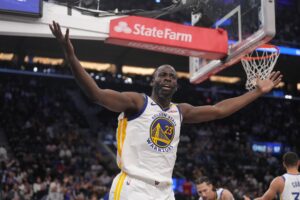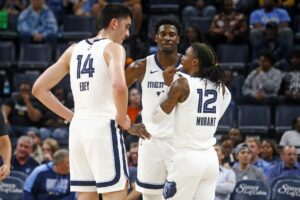I decided to dive into the controversial topic of paying college athletes using an economic approach. There are economic arguments developed by respected scholars across the country for both sides of the argument. In this case I wrote why – economically speaking – college athletes should not be paid.
I’d be foolish to not give a shoutout to Professor Hutchens of the ILR School at Cornell University for assigning this paper in class.
Economic Analysis: NCAA Athletes Should Not Be Paid
The decision to pay college athletes has been a hot topic of debate in recent years. While from an ethical standpoint it may not be appropriate for the NCAA and universities to make millions of dollars off free labor, there are too many economic implications and consequences that make it difficult to pay college athletes. On the surface it seems ideal and fair to pay college athletes for the hours of labor they put in each week; however, it’s important to analyze the trickle down of effects such a drastic change would cause.
From the perspective of labor supply, which is the number of workers who want to work in a given market, the premise of my argument is based off the claim that college athletes are already compensated economically and that there is already a sufficient level of labor supply despite “employers” offering zero wages.
As for labor demand, which is the number of workers firms want to employ in a given market, the introduction of wages for college athletes would put smaller schools with less resources and funding at a significant disadvantage. College athletics would face a major risk of smaller schools being unable to compete for wages, causing their athletic programs to become defunct and a monopoly of larger schools with a surplus of resources dominating the industry. For economic reasons that exist now and would transpire should college athletes receive wages, it is not in the best interest for most universities, the NCAA, coaches, most college athletes, or greater society to pay college athletes wages.
Economic Theory
The NCAA should be viewed as a monopsony since it forbids its member universities from paying wages to college athletes. The NCAA acts as the only “buyer” in the market for college athletes, allowing it to restrict the wage level. According to economic theory, labor demand should be far ahead of labor supply in a monopsony market when the wage is 0. However in reality, the market for college athletes does not behave this way; in fact, it is the exact opposite. Labor supply often exceeds labor demand, meaning that there are more people who desire to play college athletics than there are positions available.
Why Do College Athletes “Work” Despite No Wages?
There are multiple reasons why college athletics contrast from economic theory in this regard. First and most importantly, “workers” are willing to take on these “jobs” despite no wages for psychic benefits. For many athletes, their love and passion for their sport outweighs the downside of receiving no wages while in college. Many grow up dedicating their lives to improving at their sport, and playing in college is viewed as an accomplishment, hobby, and reward.
Additionally, college athletes are provided with free training, which is especially beneficial for those who plan on competing at the professional level. College athletes have access to elite resources, training staff, coaches, and facilities that ultimately increase their labor supply for the professional markets in the future.
Thirdly, for those who do not plan on playing professionally, college athletics is an avenue for them to receive a free education should they be rewarded a scholarship. Athletes are provided with a free education that allows them to increase their labor supply in non-athletic markets after graduation, without having to bear the typical education costs that other students must pay.
These are the three primary reasons that despite zero wages, labor supply does not drag behind labor demand in the market for college athletes. From an economic standpoint, it does not make sense for universities – acting as employers – to increase wages considering employment levels are already at the level desired by universities. Increased wages would only increase the incentive to a labor supply that already has enough incentives to “work.”
Top Athletic Programs Would Form a Monopoly
With the current wages of 0, many schools are able to compete in the market; however, if wages were to increase, it is likely that over time a monopoly of the top athletic programs would form. First off, while very few college athletic programs actually make money, the loss of profits is mitigated by the programs’ ability to avoid paying labor costs. It is likely that with increased labor costs, the losses endured by smaller athletic programs would become too great and the universities would be financially pressured to shut down the athletic program. This suggests the demand curve is rather elastic. In addition, should labor costs increase, the universities with the largest athletic programs and funding would be able to offer the highest wages and therefore compete for the best athletes. With smaller schools unable to endure the cost of paying athletes, and the larger schools having the most resources to compete for the best workers, a monopoly of top athletic programs would form.
If smaller schools no longer held athletic programs, the labor demand curve would experience movement along the curve to the left to represent a decrease in overall demand. The demand for college athletes is elastic, meaning an increase in wages would significantly decrease the number of college athletes “employed” by universities. Many college athletes who were previously willing to work at a wage of 0 would struggle to find a program demanding their labor. Skilled laborers (better athletes) would be rewarded with higher wages, but many unskilled laborers (less talented athletes who previously were good enough to play a college sport when the wage was 0) would be left searching for an opportunity that is not there for them in the market.
Overall, if a monopoly of college athletics were to form, labor demand would decrease since higher wages disincentivize or prevent programs from operating, and employment (number of college athletes) would therefore be dragged down with the decrease in demand.
Consequences Even For Those Who Benefit
Higher wages would come at great costs for the skilled athletes themselves, too. Basic economic theory suggests that as wages increase, other benefits must decrease. College athletes are already exposed to tremendous benefits, including elite facilities and coaching, free academic support, superior medical care, and road game treatment, including hotels, transportation, etc. If college athletes were to experience a significant increase in wages, the other benefits they have grown so accustomed to may no longer be provided by their universities. Is this a tradeoff college athletes are willing to take?
Empirical Evidence
Few College Athletes Benefit From Wages
Empirical evidence suggests that a very small portion of the labor pool would benefit from the introduction of wages, while universities, coaches, and less skilled players would be worse off. In 2014, just 24 of the 130 Division I FBS schools made a profit, and the only sports that individually made a profit at any school were men’s football and men’s basketball. If just 18% of the “firms” in the industry currently make a profit, then adding labor costs would have serious damages on the industry.
Based on an analysis by David Berri, a sports economist at Southern Utah University, the wages (assuming wage = marginal revenue product) needed to pay the 2012-13 Indiana University men’s basketball team would total $2,984,604. Marginal revenue product (MRP) can be defined as the increase in revenue a given worker provides to his or her firm. Economic theory suggests that under certain conditions, the wage a firm should pay a worker should equal the amount of revenue the worker provides to the firm. At Indiana University, the average scholarship value granted to student athletes was $30,000 that year, meaning $480,000 in scholarship money was used on the the 16 men’s basketball players in 2012-13. Under the assumed wage model, just over half the team (9 out of 16) would receive wages higher than the value of the scholarship they were actually compensated with. Essentially, 7 of 16 players on the team would be worse off by the introduction of wages, since the scholarship they were previously given was worth more.
It’s important to note that Indiana University’s men’s basketball program is one of the top in the nation (one that would likely be included in a monopoly of athletic programs), and yet only 56% of the team would benefit from receiving wages. This suggests that at smaller programs with less skilled athletes (meaning the MRP and thus the wage of the average player is much lower), far more than half of the team would receive wages lower than their scholarship value. If players were to be compensated based on MRP, very few players would actually earn wages higher than the value of the scholarship they are currently provided with.
Coaches Are Worse Off
Furthermore, coaches would likely see a significant drop in their salaries should players receive wages. The empirical evidence suggests that college coaches are paid more than professional coaches in comparison to the revenue brought in by their program; this provides the opportunity for universities to use some of the coach’s salary on player wages. In 2015, Duke University’s men’s basketball coach Mike Krzyzewski’s salary was representative of 17.9% of the team’s revenue. By contrast, NBA head coach Gregg Popovich’s salary was worth 4.7% of his San Antonio Spurs’ revenue for 2013-14. Both coaches are considered the top of their industries, and both won championships that year. If wages were to be paid to college athletes, much of the funding for the wages would likely come out of coaches’ salaries in order to achieve a coach’s wage to program revenue proportion similar to in the professional leagues. With significant salary decreases, coaches are worse off.
Under the wage system, universities would be forced to endure tremendous labor costs (in comparison to the current cost of 0), a majority of players would receive wages lower than the value of their scholarships, and coaches would likely experience salary drops in order to compensate the players. The only group that benefits is the best players on the few top teams in the NCAA.
Other Arguments
Should the NCAA decide to pay college athletes, there would be many more issues to debate over. Do all athletes get paid, or just the ones that bring in revenue for the university? According to basic principles of capitalism, athletes that bring the most money into the market deserve higher pay; however, it would be awfully difficult to establish a policy like this without significant uproar from proponents of all other college sports besides men’s football and men’s basketball.
If athletes were to get paid based on the marginal revenue product they bring to the athletic program, then many universities would face legal issues with regard to Title IX as well.
Furthermore, universities would struggle to find the necessary pools of money to devote to labor costs. In many cases, the university would have to use money from non-athletic departments, especially considering so few athletic programs actually generate a profit. Is it fair to the academic departments for athletics to be taking away from their budgets in order to fund college athlete wages?
In all, the economic and logistical impact of paying college athletes suggest it is not worth it. If folks truly want to see college athletes receive wages, there should be a motivation to organize and collectively bargain. Assuming they gain the right to unionize, college athletes should then organize to put pressure on the NCAA. Until that happens, the NCAA and its universities should see no motivation to offer wages to college athletes.
Main Photo
Embed from Getty Images






